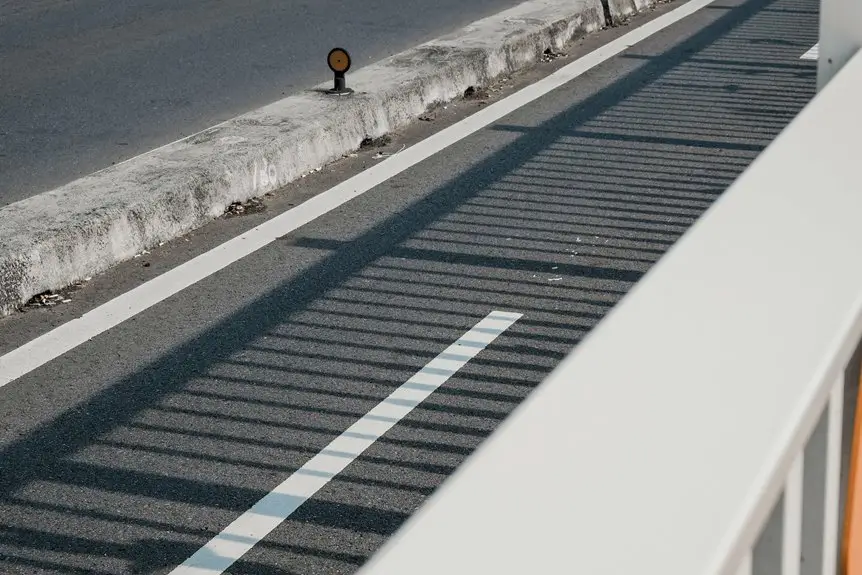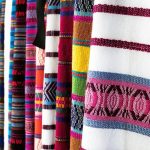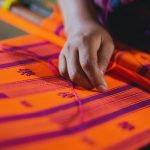You’ll find Quadrille’s famous ikat patterns rooted in traditional double-resist dyeing, where both warp and weft threads are carefully bound and dyed before weaving. They use vibrant colors like deep indigo and warm terracotta and feature signature motifs such as diamonds and chevrons symbolizing rich cultural stories. These intricate textiles bring a blend of heritage and modern design into your space. Keep exploring to discover how to incorporate and care for these timeless patterns.
Table of Contents
Key Takeaways
- Quadrille Ikat uses a double resist-dyeing technique on both warp and weft yarns for precise, vibrant patterns.
- Signature colors include deep indigo and warm terracotta, balancing traditional and contemporary aesthetics.
- Iconic motifs like diamonds and chevrons symbolize cultural stories, blending heritage with modern design.
- Quadrille Ikat fabrics are crafted on handlooms using natural dyes, emphasizing artisanal quality and texture.
- Maintenance involves gentle hand washing, air drying away from sunlight, and careful ironing with a cloth barrier.
The History and Origins of Ikat
Although ikat patterns are now popular worldwide, their roots trace back thousands of years to ancient cultures in Asia and South America.
When you explore ikat’s history, you’ll find it originated as a resist-dyeing technique applied to yarns before weaving. This method allowed artisans to create intricate, blurred designs unique to their regions.
In places like Indonesia, India, and Guatemala, ikat became a symbol of tradition and identity, often used in ceremonial garments.
As you appreciate ikat patterns today, you’re witnessing a blend of cultural heritage and artistic skill passed down through generations. Understanding these origins enriches your connection to ikat, revealing more than just beautiful fabric—it’s a story woven into every thread.
The Unique Techniques Behind Quadrille Ikat
Crafting Quadrille Ikat involves a precise resist-dyeing process that sets it apart from other ikat styles. You begin by tightly binding specific sections of the yarn before dyeing, preventing color absorption in those areas. This technique demands careful planning because the final pattern emerges only after weaving the dyed threads.
Unlike other ikat methods, Quadrille often uses a double ikat technique where both warp and weft threads are resist-dyed, creating intricate, symmetrical designs. You’ll notice the meticulous alignment required during weaving to guarantee the pattern’s clarity.
Additionally, artisans use natural dyes and handlooms, emphasizing tradition and craftsmanship. When you understand these unique techniques, you appreciate the skill and time invested in each Quadrille Ikat textile.
Signature Colors and Motifs in Quadrille Designs
You’ll notice Quadrille designs often feature iconic color palettes that make their patterns stand out.
Traditional Ikat motifs bring a rich cultural history to each piece, while modern influences add fresh twists you’ll appreciate.
Let’s explore how these elements come together to create unique and vibrant designs.
Iconic Color Palettes
Colors and motifs define the unmistakable charm of Quadrille’s Ikat patterns. When you explore their iconic color palettes, you’ll notice a perfect balance of vibrancy and subtlety that brings each design to life.
Here’s what you should know about Quadrille’s signature hues:
- Deep Indigo – Offers rich depth and a timeless feel.
- Warm Terracotta – Adds earthy warmth, grounding the patterns.
- Soft Sage Green – Provides a calming contrast to bolder shades.
- Crisp Ivory – Brightens designs and highlights intricate details.
These palettes use color to evoke emotion and complement the geometric and abstract motifs without overwhelming them.
When you choose Quadrille Ikat designs, these colors guarantee your space feels both sophisticated and inviting.
Traditional Ikat Motifs
Traditional Ikat motifs in Quadrille designs capture a rich cultural heritage while adding dynamic visual interest to your space.
You’ll notice distinctive patterns like diamonds, chevrons, and feathered shapes—each symbolizing stories and traditions passed down through generations. These motifs often feature blurred edges, a hallmark of the Ikat dyeing technique, creating a sense of movement and depth.
When you incorporate Quadrille’s traditional Ikat designs, you bring timeless artistry into your décor, blending cultural significance with bold aesthetics.
The carefully chosen signature colors, often earthy tones mixed with vibrant accents, enhance these motifs’ impact.
Modern Design Influences
While rooted in heritage, Quadrille’s modern Ikat designs push boundaries by embracing bold, unexpected color palettes and sleek motifs.
When you explore these patterns, you’ll notice how they blend tradition with contemporary flair.
Here’s what sets Quadrille’s modern Ikat apart:
- Vibrant jewel tones like emerald, sapphire, and amethyst that add a luxurious feel.
- Minimalist geometric shapes replacing more intricate traditional forms.
- High-contrast color combinations that catch your eye instantly.
- Abstract and asymmetrical layouts offering a fresh, dynamic look.
How to Incorporate Ikat Patterns Into Your Home
You can bring Ikat patterns into your home by carefully choosing color schemes that complement your existing decor.
Mixing Ikat with other patterns adds visual interest without overwhelming your space.
Start with Ikat textiles like pillows or throws for an easy, stylish update.
Choosing Ikat Color Schemes
How can you select the perfect color schemes to make Ikat patterns shine in your home? Start by considering your room’s existing palette to guarantee harmony. Ikat’s vibrant designs deserve colors that complement rather than compete.
- Choose a dominant color from your Ikat pattern and repeat it in accents like pillows or curtains.
- Use neutral backgrounds—whites, creams, or greys—to let Ikat’s colors pop without overwhelming.
- Incorporate one or two secondary colors from the Ikat to add depth and balance.
- Experiment with muted versions of Ikat hues for a subtle, cohesive look.
Mixing Patterns Effectively
Incorporating Ikat patterns into your home means mastering the art of mixing prints without creating visual chaos. Start by balancing Ikat with solid colors to let its dynamic design shine.
Pair bold Ikat motifs with smaller, subtle patterns like stripes or dots that share a similar color palette. This contrast adds depth without overwhelming your space. Use Ikat on statement pieces—like throw pillows or an accent chair—while keeping larger areas neutral.
Don’t be afraid to mix different Ikat scales; large patterns work well with smaller ones to create harmony. Finally, consider texture to add dimension, combining Ikat fabrics with smooth or woven materials.
Ikat in Textiles
Mastering the mix of Ikat patterns sets a strong foundation for bringing this vibrant design into your textiles.
To incorporate Ikat into your home, start with these simple steps:
- Choose Ikat throw pillows to instantly add color and texture to your sofa or bed.
- Use an Ikat area rug to anchor your living space with bold, geometric flair.
- Incorporate Ikat curtains to frame windows and let natural light enhance the patterns.
- Select upholstery fabric with Ikat motifs for accent chairs or ottomans to create focal points.
Comparing Traditional and Modern Ikat Styles
Although both traditional and modern Ikat styles share the same dyeing technique, they differ considerably in design, color palette, and cultural significance. When you explore traditional Ikat, you’ll notice intricate, symbolic patterns often tied to cultural stories. Modern Ikat, however, embraces bold, abstract designs and vibrant or muted palettes, appealing to contemporary tastes. Understanding these contrasts helps you appreciate the fabric’s evolution.
| Aspect | Traditional Ikat |
|---|---|
| Design | Symbolic, intricate |
| Color Palette | Earthy, natural tones |
| Cultural Significance | Deeply rooted in heritage |
| Usage | Ceremonial, everyday wear |
| Aspect | Modern Ikat |
| Design | Abstract, bold |
| Color Palette | Bright, experimental |
| Cultural Significance | Fashion-forward |
| Usage | Home decor, apparel |
Caring for and Maintaining Ikat Fabrics
Because Ikat fabrics rely on a delicate dyeing process, you need to handle them with extra care to preserve their vibrant patterns and textures.
Ikat fabrics require gentle care to maintain their vibrant, intricately dyed patterns and textures.
Here’s how you can maintain your Ikat pieces:
- Hand wash gently in cold water with mild detergent to prevent color bleeding.
- Avoid wringing or twisting; instead, press out water softly and air dry away from direct sunlight.
- Iron on a low setting with a cloth barrier to protect the fabric’s surface.
- Store in a cool, dry place, folded neatly or rolled to avoid creases and fabric stress.
Frequently Asked Questions
Where Can I Purchase Authentic Quadrille Ikat Fabrics?
Think of an art gallery filled with vibrant colors—that’s where you find authentic Quadrille Ikat fabrics. You can purchase them directly from Quadrille’s official website or specialty fabric stores that carry designer textiles.
Are Quadrille Ikat Patterns Suitable for Outdoor Use?
Quadrille Ikat patterns are typically designed for indoor use due to their delicate fabric and dye techniques. If you want outdoor durability, you’ll need specially treated or synthetic materials that resist fading and weather damage.
What Is the Average Price Range for Quadrille Ikat Textiles?
Think of Quadrille Ikat textiles as treasure chests; their average price ranges from $50 to $200 per yard. You’ll find quality varies, so you’ll want to pick one that fits your style and budget perfectly.
Do Quadrille Ikat Designs Come in Custom Sizes?
You can get Quadrille Ikat designs in custom sizes to fit your space perfectly. They offer flexibility, so you won’t have to compromise on your design vision or worry about awkward measurements.
Can Quadrille Ikat Patterns Be Used in Fashion Apparel?
You’ll be excited to know 78% of designers choose ikat patterns for apparel. You can definitely use these bold, vibrant designs in fashion, adding unique texture and eye-catching style to your clothing creations effortlessly.
- A Guide to Quadrille’s Famous Ikat Patterns - June 28, 2025
- Exploring the Rich Hues of Purple and Plum Ikat Fabric - June 28, 2025
- The Difference Between Ikat and Kilim Patterns - June 28, 2025







